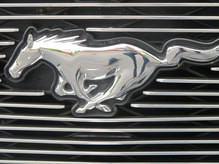 Image © by Brian E. Faulkner
Image © by Brian E. Faulkner An atmosphere of trust and cooperation can be set within an organization, claims Simon Sinek, a former adman who has transformed himself into a speaker and writer on inspired leadership, including Start With Why: How great leaders inspire everyone to take action and the book he was touting on NPR, Leaders Eat Last: Why some teams pull together and others don’t.
“Leadership sets the tone,” Sinek said during the interview, by establishing a “circle of safety” in which trust is paramount and people do not get sacrificed in favor of numbers. Ron Kaplan, CEO of Trex, a manufacturer of outdoor decks, expressed a similar sentiment in a recent Sunday New York Times Corner Office column in reflecting on something his combat veteran father told him: “That the No. 1 job of a leader is to make the staff feel secure.”
Sinek concurs in counseling leaders to put people first, much like the Marine Corps general he once observed waiting with his senior officers until their men had been served before joining the tail end of the chow line.
Leadership, like quality, is tough to define. Some say it’s simply the art of getting followers to go where you want them to go. Leadership consultant Dusty Staub once told me that his father, also a military man, defined leadership a bit more abstractly. “Leadership is a simple task,” he said. “It’s a lot like drinking water and whistling at the same time.”
Of course, writing about leadership is one thing. Doing it is another. I know that from experience, by having come to grips with my own poor leadership skills as president of a small company and by observing over many years the leadership skills (or not) of the many C-level clients for whom I have consulted on communication issues. It was fascinating to observe how a few of my president/CEO clients couldn’t be recognized on a walk through the company lunchroom while others could transform a walk through the plant into old-home week with handshakes and glad tidings all around. Some clients wanted to lead but didn’t have the self-effacement to do so. Others tried to be chummy but came across as clumsy and disconnected,.
The Gift of Leadership.
My personal observation suggests yes, that leadership is -- in great part -- an inborn quality that cannot readily be learned from reading books or listening to lectures. The best leaders are like the truly gifted athletes you see whose performance has an almost effortless ease about it.
I cite as example one particularly memorable client, who began a company almost quite literally in a closet of a parent firm. His fledgling business grew rapidly and within a few years it had established itself as the national leader in a heretofore undisciplined business category. They created a great brand that solidly addressed their customers’ needs, were excellent marketers and didn’t have to establish their own manufacturing plants. But mostly, they had a superb leader who not only was able to dream big but wrap people into his vision of the future and inspire them to want to help him get there. They were a tight team that worked hard and played hard. They had a common cause. They trusted one another. And truly anything was possible as they forged a path into uncharted market territory. When the leader left (given broader responsibility higher up in “corporate”), the thread of trust he’d established dissolved. The new company president was a strong and capable manager (and certainly looked the part) but didn't have the the gift of leadership.
In his radio interview, Sinek mentioned Costco as an example of a company that invests in its people – often at the expense of Wall Street. I know little about Costco but can appreciate what he said about them. Time after time, I have seen senior managers crash and burn in admirable efforts to inspire employees because they didn’t "make plan” and had to get tough or because corporate suddenly decided to ship some of their jobs offshore.
“Leadership is an art,” Max De Pree once proclaimed in his powerful little book of the same name, the act of “liberating people to do what is required of them in the most effective and humane way possible.”
The covenant between leaders and their followers that he describes is very Christ-like, a self-sacrificial model of leadership that in these days – any days – is all too uncommon.
TakeAway: True leaders make it possible for others to succeed. Hold onto these rare treasures with everything you’ve got.
Content © by Brian E. Faulkner
Tags: Leaders Eat Last, Simon Sinek, leadership, Ron Kaplan, Trex, Adam Bryant, Corner Office, Dusty Staub, Max De Pree, Leadership is an Art, Costco
About Brian Faulkner.
Brian also is a five-time Emmy award winning Public Television writer and narrator of UNC-TV’s popular Our State magazine series, on the air since 2003.

 RSS Feed
RSS Feed